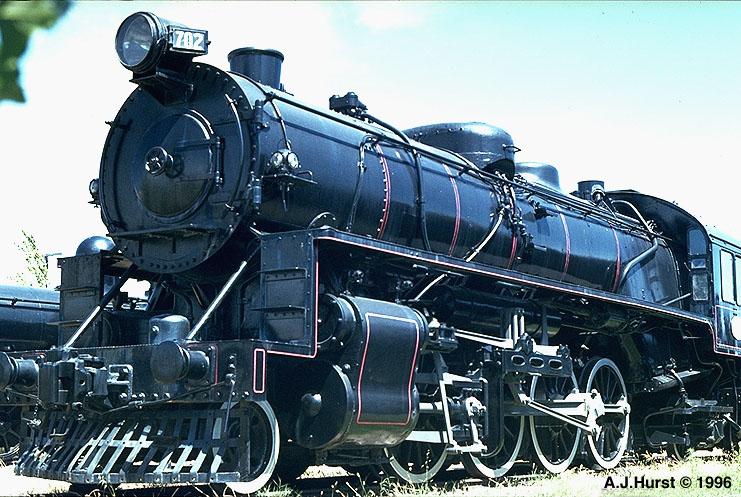
|
702 National Railway Museum, Port Adelaide |

702 displayed at the National Railway Museum, Port Adelaide on 24 September 2005.
|
In 1926 the South Australian Railways received the first American-style "big engines" of the 500, 600 and 700-classes under the leadership of Commissioner W. A. Webb. The 500 (4-8-2), 600 (4-6-2) & 700 (2-8-2) classes were all designed by F. J Shea, Chief Mechanical Engineer of the South Australian Railways. Ten examples of each class were built by Sir W. G. Armstrong Whitworth & Co Ltd at their Newcastle-Upon-Tyne works, with the first of the big engines to arrive being Mikado No.700. The big engines revolutionised rail haulage in a state previously characterised by smaller UK-style locomotives, eliminating double-heading, enabling the introduction of more modern heavy passenger carriages and improving freight capacity and transit times. The South Australian Railways required a program of civil engineering improvements prior to introduction of the big engines, such as the elimination of the spindly Sleeps Hill viaduct in the Adelaide Hills. The 700-class Mikados proved successful in operation and enjoyed greater router availability that the other big engines due to their lower axle load. 10 further examples were built by Islington Workshops in 1928 and 1929 with slight design improvements, including somewhat larger tenders; these handsome locomotives became known as the 710-class. Islington Workshops continued development of the 700-series when a 2-8-4 version was rolled out in 1930, numbered from 720 onwards. The 17 members of the 720-class were heavier than the preceding 700 / 710 classes, sporting a larger boiler and a four-wheel booster truck under the firebox (hence the 2-8-4 wheel configuration). A full-length valance along the footplate (similar to that fitted to members of the the 500B class) hid the steam pipe to the booster truck. The 720-class also featured a large, high capacity 12-wheel tender. A further batch of twenty 2-8-2 locomotives of the original 700-class design were constructed by Clyde Engineering Co. in Sydney after World War 2. These engines were originally intended as Australia's contribution to United Nations relief to China, prior to the Communist revolution. Ten of these locomotives were obtained by the SAR and converted to 5' 3" gauge, becoming the 740-class, while the other ten went to the Commonwealth Railways as their L-class. Unfortunately the South Australian Railways big engines didn't fare well in preservation, with most being quickly withdrawn and scrapped in the early 1960's as victims of the switch to diesel traction. The heavy 720's were less versatile than other members of the 700-family and confined to mainline freight, hence were quickly replaced my first-generation diesels. They were withdrawn between 1958 and 1960 and quickly dispatched for scrap metal. The lighter axle-load 2-8-2's fared better; many were withdrawn in the early 1960's but some continued in service through the mid-1960's. The last of the 740-class was No.747 which was scrapped in 1966. However class leader No.700, the very first of the big engines, worked until as late as 1968 and even double-headed with the last of the 710-class, No.718 on an enthusiast tour train during that year. Unfortunately both were scrapped shortly after. (I understand there was consideration given to adding No. 700, 747 &/or 718 to the Mile End collection but it was decided against, given space restrictions at Mile End and the close similarity of the 700, 710 and 740-classes which would have unbalanced the collection. Equally, their low speed would have counted against their retention as part of the steam excursion fleet.) Preserved engine No.702 was built by Armstrong Whitworth & Co as their builder's number 645 of 1926. It was condemned in July 1964 with 775,526 miles clocked, entering the open-air Mile End museum in June 1965. The Mile End Railway Museum was superceded by the Port Dock Station Museum, Port Adelaide in 1988 and 702 and the other Mile End exhibits were transferred there in 1988. 702 is now prominently displayed in the main exhibit hall of the National Railway Museum as the last survivor of the 700-series of heavy freight locomotives. |

An earlier scanned photo view of 702 at the National Railway Museum.

This view is courtesy of
John Hurst and shows 702 displayed at the Mile End Railway Museum in 1973.
References
|
a |
Fluck R. E., Sampson R., & Bird K. J. 'Steam locomotives and Railcars of the South Australian Railways', published by The Mile End Railway Museum (SA) Inc, 1986. |
|
b |
Wilson, J. 'The Mile End Railway Museum, the first ten years', published by the Australian Railway Historical Society (SA Division) Inc., 1974. |
Page updated: 18 December 2014